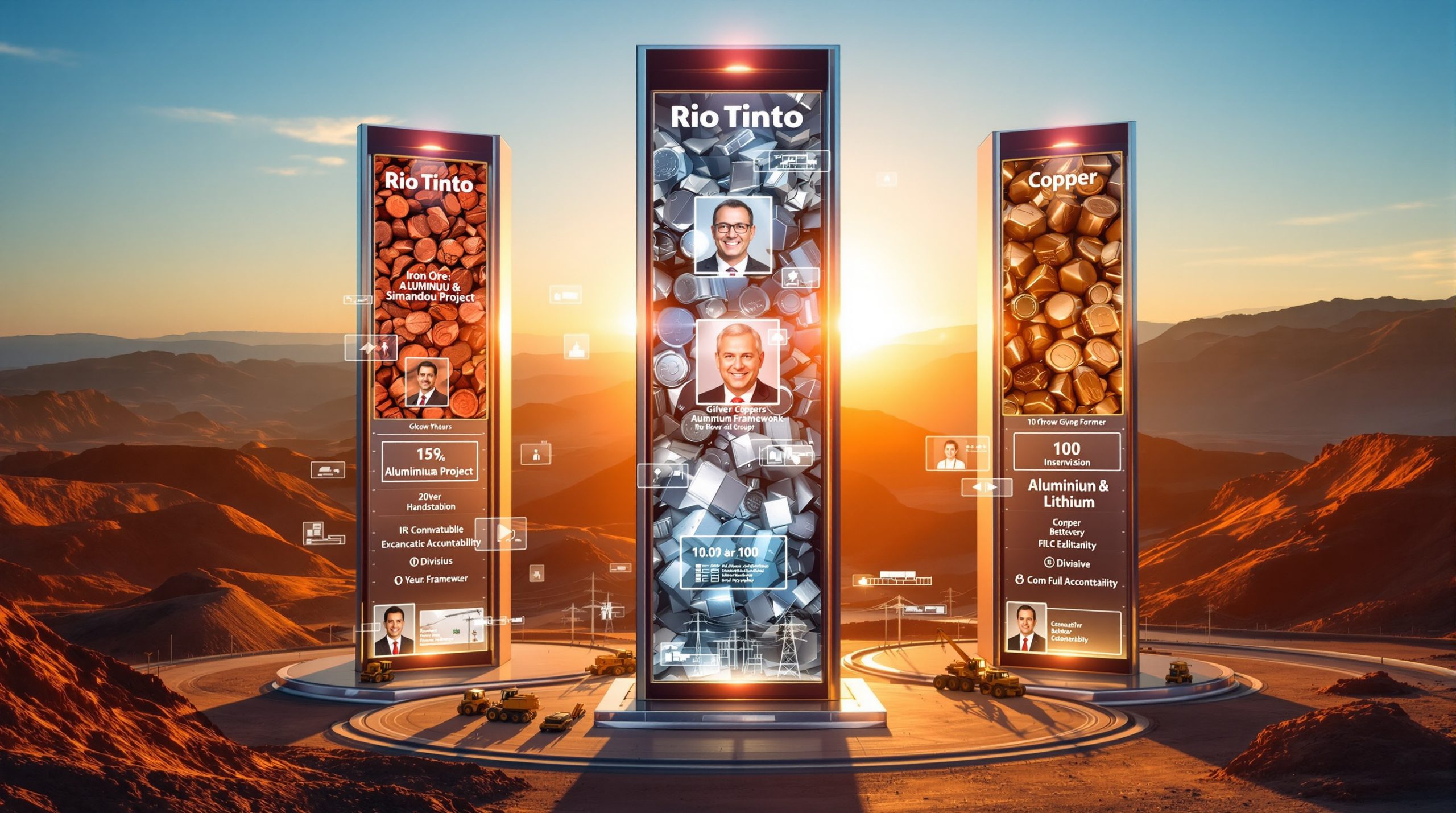Rio Tinto's Strategic Transformation: A New Operating Model for Global Mining Excellence
How is Rio Tinto Restructuring its Business Operations?
Rio Tinto, one of the world's largest mining companies, has unveiled a transformative operating model aimed at streamlining operations, enhancing accountability, and driving sustainable growth. This strategic reorganization represents a significant shift in how the global mining giant structures its business units to maximize competitive advantages in an evolving industry landscape.
With a market capitalization of approximately $95 billion as of 2024, Rio Tinto's restructuring announcement on August 27, 2025, signals a major strategic pivot for the world's second-largest mining company.
The restructuring focuses on simplifying the organizational structure while enhancing operational focus on the company's most promising growth opportunities. By consolidating its product groups and establishing clearer lines of accountability, Rio Tinto aims to drive operational excellence and create greater long-term shareholder value.
What Are the Key Components of Rio Tinto's New Operating Model?
Streamlined Product Group Structure
The most significant change in Rio Tinto's new operating model is the consolidation of its business units into three focused product groups:
| Product Group | Leadership | Key Components |
|---|---|---|
| Iron Ore | Matthew Holcz | All iron ore operations globally, including Simandou project (Guinea) |
| Aluminium & Lithium | Jérôme Pécresse | Combined processing operations with downstream exposure |
| Copper | Katie Jackson | Positioned to capitalize on energy transition opportunities |
This simplified structure allows each business unit to focus on its core competencies while benefiting from being part of Rio Tinto's diversified portfolio. The consolidation represents a significant departure from the company's previous more complex organizational arrangement.
Enhanced Accountability Framework
The restructuring places greater emphasis on accountability at all levels of the organization. By clarifying reporting lines and decision-making processes, Rio Tinto aims to:
- Accelerate operational improvements
- Enable more agile responses to market changes
- Drive consistent implementation of safety protocols
- Improve capital allocation discipline
This enhanced accountability framework aligns with CEO Simon Trott's vision for creating "greater accountability and focus" throughout the organization.
Integration of Similar Business Units
The merger of the Lithium business into the Aluminium product group represents a strategic alignment of operations with similar processing capabilities and downstream exposure. This integration enables:
- Shared deployment of productivity initiatives
- Implementation of proven systems like the safe production system
- Streamlined operational processes
- More efficient resource allocation
According to the company announcement, the combined product group will "deliver a streamlined structure, bringing together businesses centred on processing capability and downstream exposure" while enabling "the shared deployment of productivity initiatives, such as the safe production system."
Why is Rio Tinto Implementing This New Operating Model?
Driving Operational Excellence
The simplified business structure is fundamentally designed to achieve new standards of operational excellence across Rio Tinto's global portfolio. By reducing organizational complexity, the company can:
- Focus management attention on critical performance metrics
- Standardize best practices across similar operations
- Reduce administrative overhead
- Accelerate decision-making processes
The restructuring reflects a more disciplined approach to operational performance, with CEO Simon Trott emphasizing how the changes will "enable us to deliver new standards of operational excellence and value creation."
Maximizing Growth Opportunities
Rio Tinto's strategic reorganization positions each product group to capitalize on its most compelling growth opportunities:
-
Iron Ore: Unifying all iron ore operations, including the strategic Simandou project in Guinea, under single leadership enables coordinated development and operational synergies.
-
Aluminium & Lithium: Combining these businesses leverages processing expertise while positioning Rio Tinto to benefit from growing demand for both materials in the energy transition.
-
Copper: Maintaining a dedicated copper business unit acknowledges the metal's critical role in global electrification and renewable energy infrastructure, with the company noting this division "remains well positioned to capitalise on the global energy transition."
Enhancing Capital Discipline
The new operating model reinforces Rio Tinto's commitment to disciplined capital allocation. By establishing clearer accountability for investment decisions, the company aims to:
- Prioritize projects with the highest return potential
- Maintain financial strength through market cycles
- Balance growth investments with shareholder returns
- Ensure rigorous evaluation of capital expenditures
The company specifically highlighted a "more disciplined approach to operational performance and capital investment" as a key driver behind the restructuring.
How Will the New Operating Model Impact Rio Tinto's Global Operations?
Unified Iron Ore Portfolio
The consolidation of all iron ore operations under Matthew Holcz's leadership creates a truly global iron ore business. This integration:
- Brings together Australian and West African operations
- Enables knowledge transfer between established and developing assets
- Creates opportunities for operational standardization
- Positions the Simandou project within Rio Tinto's broader iron ore strategy
With Rio Tinto producing approximately 327.4 million tonnes of iron ore in 2023, this unified approach to managing iron ore assets represents a significant operational shift. The company's focus on iron ore demand insights remains critical to its long-term strategy.
Enhanced Processing Capabilities
The combined Aluminium & Lithium product group under Jérôme Pécresse leverages Rio Tinto's extensive processing expertise. This integration:
- Applies aluminum processing innovations to lithium operations
- Expands downstream value-creation opportunities
- Strengthens Rio Tinto's position in energy transition materials
- Enables more efficient deployment of technical resources
The safe production system that has driven performance improvements in aluminum operations will now be deployed across the combined business unit, potentially generating significant operational synergies. Recent lithium industry innovations highlight the importance of this strategic consolidation.
Focused Copper Development
Maintaining Copper as a distinct product group under Katie Jackson's leadership reflects its strategic importance. This focused approach:
- Maintains dedicated attention on copper project development
- Positions Rio Tinto to benefit from growing copper demand
- Enables specialized expertise in copper mining and processing
- Supports targeted growth in this critical mineral sector
What Are the Expected Benefits of Rio Tinto's Restructuring?
Improved Safety Performance
Safety remains Rio Tinto's fundamental priority, and the new operating model aims to enhance safety outcomes through:
- Clearer accountability for safety performance
- More consistent implementation of safety systems
- Accelerated sharing of safety innovations between operations
- Enhanced focus on critical risk management
CEO Simon Trott specifically emphasized that the new structure is "grounded in our fundamental commitment to safety" as a cornerstone of the restructuring.
Sustainable Growth Opportunities
The restructured organization is designed to deliver sustainable, profitable growth by:
- Focusing on the most compelling development opportunities
- Enhancing project execution capabilities
- Improving responsiveness to market changes
- Strengthening partnerships with host communities and governments
The company's emphasis on "sustainable, profitable growth through focusing on the most compelling opportunities" indicates a strategic prioritization of high-potential projects.
Enhanced Operational Efficiency
By simplifying its organizational structure, Rio Tinto expects to achieve:
- Reduced administrative complexity
- More efficient decision-making processes
- Better resource allocation
- Improved cost management across operations
The streamlined structure aims to eliminate bureaucratic layers that may have previously impeded efficient operations.
Strengthened Competitive Position
The new operating model positions Rio Tinto to strengthen its competitive advantages through:
- More focused business units with clear strategic direction
- Enhanced ability to respond to industry challenges
- Improved capability to capitalize on growth opportunities
- Stronger alignment between corporate strategy and operational execution
How Does This Restructuring Compare to Industry Trends?
Alignment with Mining Industry Evolution
Rio Tinto's organizational changes reflect broader industry evolution trends toward:
- Simplified corporate structures
- Enhanced operational focus
- Greater emphasis on energy transition materials
- Improved capital discipline
While Rio Tinto isn't the first major mining company to streamline its organizational structure, the specific focus on aligning business units with growth opportunities represents a distinctive approach.
Strategic Positioning for Future Challenges
The new operating model positions Rio Tinto to address key industry challenges:
- Increasing complexity of resource development
- Growing emphasis on ESG performance
- Rising competition for tier-one assets
- Evolving stakeholder expectations
The restructuring acknowledges the changing landscape of the global mining industry, particularly the growing importance of materials critical to the energy transition. The company's approach aligns with broader mining transformation strategies being adopted across the sector.
Competitive Differentiation
Rio Tinto's restructuring creates potential competitive advantages through:
- Clearer strategic focus for each product group
- Enhanced operational accountability
- More efficient deployment of technical expertise
- Improved capital allocation processes
What Challenges Might Rio Tinto Face in Implementing the New Model?
Organizational Transition Management
Implementing such significant organizational changes presents challenges:
- Maintaining operational continuity during transition
- Preserving institutional knowledge
- Managing cultural integration between combined units
- Ensuring consistent communication across stakeholders
The success of the restructuring will depend significantly on how effectively Rio Tinto manages these organizational transition challenges.
Project Execution Risks
The restructuring coincides with major project developments:
- Simandou iron ore project in Guinea
- Copper project pipeline development
- Lithium expansion initiatives
Maintaining focus on these critical projects while implementing organizational changes will require careful management to avoid disruptions to development timelines or budgets.
Market and Geopolitical Uncertainties
External factors that could impact the restructuring's effectiveness include:
- Commodity price volatility
- Changing regulatory environments
- Geopolitical tensions in operating regions
- Evolving stakeholder expectations
Rio Tinto will need to maintain flexibility in its implementation approach to adapt to these external uncertainties. Recent industry consolidation insights suggest this is a common challenge across the mining sector.
How Will Success Be Measured?
Key Performance Indicators
Rio Tinto's success in implementing its new operating model will likely be measured through:
- Safety performance metrics
- Operational efficiency improvements
- Project delivery against schedules and budgets
- Financial returns and shareholder value creation
- ESG performance indicators
While specific metrics haven't been publicly detailed, these standard industry performance indicators will likely form the basis for evaluating the restructuring's success.
Long-term Strategic Outcomes
Beyond immediate operational metrics, success will ultimately be judged by:
- Sustainable growth in production volumes
- Improved capital efficiency
- Enhanced competitive position
- Strengthened relationships with host communities and governments
- Long-term shareholder returns
The company's explicit focus on "long-term shareholder value" indicates that sustainable financial performance remains a primary measure of success.
What Does This Mean for Rio Tinto's Future?
Strategic Evolution
The new operating model represents an evolution of Rio Tinto's strategy, emphasizing:
- Focused growth in core commodities
- Enhanced operational excellence
- Disciplined capital allocation
- Sustainable business practices
This evolution reflects Rio Tinto's adaptation to changing market conditions and stakeholder expectations.
Positioning for Industry Leadership
By implementing these changes, Rio Tinto aims to:
- Reinforce its position as an industry leader
- Enhance its ability to create value through market cycles
- Strengthen its portfolio of world-class assets
- Build a more resilient and adaptable organization
Frequently Asked Questions About Rio Tinto's New Operating Model
How will the new operating model affect Rio Tinto's global workforce?
While specific workforce impacts haven't been detailed, organizational restructuring typically involves some role changes. The focus appears to be on streamlining management structures rather than broad workforce reductions, with emphasis on creating clearer accountability and more efficient decision-making processes.
What does the integration of Lithium with Aluminium mean for Rio Tinto's battery materials strategy?
Combining Lithium with Aluminium under unified leadership suggests Rio Tinto sees operational synergies between these businesses. This integration could accelerate the application of processing innovations across both materials while positioning the company more strongly in the energy transition materials sector.
How might the restructuring impact Rio Tinto's Simandou project in Guinea?
The integration of all iron ore operations, including Simandou, under unified leadership likely aims to apply Rio Tinto's extensive iron ore expertise to this strategic project. This could enhance project execution while ensuring the development aligns with the company's broader iron ore strategy.
Will the new operating model affect Rio Tinto's sustainability commitments?
The restructuring appears designed to enhance accountability and operational focus, which should support rather than detract from Rio Tinto's sustainability commitments. Clearer lines of responsibility could potentially strengthen implementation of environmental and social initiatives.
Disclaimer: This article contains analysis of corporate restructuring and potential future outcomes. These views represent interpretations of publicly available information and should not be considered as financial advice or investment recommendations. Future performance may differ significantly from expectations discussed in this analysis.
Looking for the Next Major Mineral Discovery on the ASX?
Discovery Alert's proprietary Discovery IQ model provides real-time notifications when significant mineral discoveries are announced on the ASX, giving you an immediate advantage in the market. Explore how historic discoveries have generated substantial returns for early investors by visiting our dedicated discoveries page and start your 30-day free trial today.




